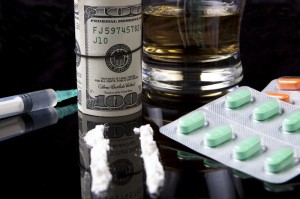Drug Addiction
 For decades, women have fought hard to be on an equal footing with men. They’ve staged protests, lobbied for effective protections, delivered rousing speeches and penned thousands of books, articles and poems about the need for gender-based equality in all areas of life. In most cases, equality that has been achieved has been met with great fanfare and celebration. However, there are times when equality isn’t always the best outcome for women.
For decades, women have fought hard to be on an equal footing with men. They’ve staged protests, lobbied for effective protections, delivered rousing speeches and penned thousands of books, articles and poems about the need for gender-based equality in all areas of life. In most cases, equality that has been achieved has been met with great fanfare and celebration. However, there are times when equality isn’t always the best outcome for women.
Addiction provides the best example of this fact. While women have lagged behind men in rates of drug addiction for decades, evidence suggests that the tide has been turning and that women are reaching the same levels of addiction that were once only held by men. The consequences can be deadly.
Women and Prescription Drug Addiction
For decades, addictions in women have begun with simple trips to the doctor’s office. In a review of addiction in women, the authors Shulamith Lala, Ashenberg Straussner and Patricia Rose Attia suggest that drug addiction in women first came into prominence in the 1880s, when doctors were encouraged to provide laudanum, or opium dissolved in alcohol, for women who had pain or nervous conditions. Many of these women simply couldn’t stop taking the drug once they had started, and they were nearly incapacitated by their addictions. The addiction wasn’t considered dangerous or deadly, however, because it was so common. This means that many women might have been addicted, and since they didn’t know they were addicted, they never got help.
In the 1950s, the article continues, women began seeing their doctors for amphetamines for weight loss and barbiturates for sleep. Some women even received prescriptions for sedatives, so they could reduce the anxiety they felt on a daily basis. These might have been prescription drugs, but they were certainly far from safe, and many women who took them were simply unable to stop doing so, once they had started. This might be attributed, in part, to the fact that medical professionals and patients alike simply didn’t realize that these drugs were addictive or dangerous. In a study published in 1976, in the journal Substance Use and Misuse, the responses that doctors provided varied dramatically when they were told the substance in question was diazepam. In other words, the doctors looked negatively on the responses seen by patients, until they were told what the drug was. Their opinions were hijacked by what they had been told about the drug, and what it could do.
Biased doctors like this are unlikely to explain risks to their clients, and help them to avoid subsequent addictions.
While medical professionals know more about addiction now than they did in the past, modern women may still obtain addictions after visiting their doctors. In fact, many women develop addictions to strong painkillers like Vicodin or OxyContin after taking the drugs for major injuries. For example, the New York Times reported that pregnant women were taking prescription painkillers in record numbers, and they were delivering babies who were addicted to these powerful drugs. Some women certainly obtained these drugs from their doctors via valid prescriptions, but many others likely obtained the drugs from family members and friends on an illicit basis.
Painkillers aren’t the only prescription medications that women become addicted to in the modern world. In fact, many women become addicted to:
Addictive Drugs
- Stimulants
- Sedatives
- Tranquilizers
- Opiate substitutes used for addiction care
But, while prescription drug abuse is certainly a problem for women, these aren’t the only drugs women can become addicted to. In fact, women are also developing addictions to illicit drugs like heroin, marijuana and cocaine. In fact, they might be catching up to men in this regard.
Addiction and Modern Women
 Today we live in an era when women become addicted to the full suite of drugs men do. According to a report published by the National Center on Addiction and Substance Abuse at Columbia University (CASA) in 1996, “Women are increasingly likely to abuse substances at the same rate as men, and women are starting to smoke, drink and use drugs at earlier ages than ever before.” It’s clear that women are making dangerous inroads into drug addiction, and feeling terrible consequences as a result.
Today we live in an era when women become addicted to the full suite of drugs men do. According to a report published by the National Center on Addiction and Substance Abuse at Columbia University (CASA) in 1996, “Women are increasingly likely to abuse substances at the same rate as men, and women are starting to smoke, drink and use drugs at earlier ages than ever before.” It’s clear that women are making dangerous inroads into drug addiction, and feeling terrible consequences as a result.
Women’s bodies are simply not the same as men’s bodies. Their bodies are smaller, allowing their systems to be overwhelmed with signals even when using small amounts of drugs. Some researchers also suggest that women’s hormone levels play a role in how quickly drugs of abuse set to work, and how large the addictive response is in return. Researchers at CASA believe, after conducting much of this research, that women tend to become addicted to substances of abuse much quicker than men simply because the responses they receive from the drugs they abuse is so much more profound. The pleasurable response is larger, and harder to ignore, so addictions are more likely to follow.
Women can also become addicted to activities, just like men do, including:
- Gambling
- Sexual activity
- Shopping
- Online gaming
Many of these activities cause large releases of pleasurable chemicals in the brain, causing the same sort of addictions that drugs can cause. Recovering from these addictions can be just as difficult as recovering from a substance abuse issue.
How Addictions Form
 The truth about addiction is that the drug of choice ultimately makes little difference. Addiction itself is a disease that begins with chemical changes in the brain, and those changes can be hard to overcome without help.
The truth about addiction is that the drug of choice ultimately makes little difference. Addiction itself is a disease that begins with chemical changes in the brain, and those changes can be hard to overcome without help.
Most addictive drugs work on specific chemical pathways in the brain. The drugs latch onto receptors in the brain, causing the brain to release large amounts of chemicals it would normally release when introduced to something pleasurable, such as hot food or a warm bath. The flooding of chemicals may make the person feel wonderful, but the brain may attempt to keep balance by turning off receptors and reducing the availability of specific chemicals in the brain. As a result, when people stop taking drugs, they are working with a brain that has been customized to function properly only in the presence of drugs, and that brain may call out for drugs through devastating side effects and withdrawal symptoms. People who are addicted to opiates, for example, may feel queasy and sweaty when they’re not provided with drugs. People addicted to cocaine may experience crushing depression when their drugs are removed. Most people, however, no matter what drugs they use, report feeling an increasing urge to take drugs again, no matter the consequences, and those cravings can be hard to deal with and almost impossible to ignore.
Addictions are more than merely physical
People who are addicted to drugs tend to make terrible choices in their lives, hurting their friends and family members, as well as reducing their own chances for success. This damage can lead to a significant amount of mental distress. In women, the link between addiction and mental illnesses such as depression are particularly strong. For example, a study of addicted women published in the Journal of Substance Abuse Treatment found that over half had a diagnosed history of depression. It’s likely that many more women in this group had an episode of depression that was never diagnosed. This link between addiction and mental and social distress is rarely discussed by mainstream media sources, even though it may be of great concern to women who are addicted. In order to heal, these women might need opportunities in which to repair their damaged relationships, and they might also need the ability to connect with other women who are also going through their own addiction recovery process. By knitting together their social lives in this way, addicted women may be able to heal from these devastating addictions.
Help at The Orchid
 The epidemic of growing drug abuse among women has been largely ignored by the mainstream media. In fact, many studies on addiction, and articles about addiction among Americans, have focused on men. Studies of medications that are often used to treat addiction have also mainly focused on men. As a result, many women who have addictions are forced to use methods that have been tailored for men, and they haven’t always been effective. At The Orchid, we’ve set out to change that.
The epidemic of growing drug abuse among women has been largely ignored by the mainstream media. In fact, many studies on addiction, and articles about addiction among Americans, have focused on men. Studies of medications that are often used to treat addiction have also mainly focused on men. As a result, many women who have addictions are forced to use methods that have been tailored for men, and they haven’t always been effective. At The Orchid, we’ve set out to change that.
When The Orchid was founded, administrators chose to cater to the particular needs of female addicts. Instead of “brute strength” approaches and outdated psychological models, The Orchid approach is founded largely on the groundbreaking work of Dr. Karen Dodge. Much of her study has centered on the tremendous benefit accorded women who can commiserate with, and draw strength from, other women in a therapeutic environment. This means that The Orchid provides standard treatments for addiction, including one-on-one therapy sessions and medication management, as needed, but The Orchid also emphasizes narrative approaches to therapy, allowing women to speak their minds and share their stories. Women are also encouraged to attend many support group meetings with other addicted women, and they are asked to share their stories in informal settings as well. The setting is warm, comforting, and built on trust and sharing. It can be a healing environment that women would find transformative.
Free. Easy. Confidential.
Call Today: 1-800-469-9124
Who Answers?We have caring admissions counselors available 24/7
The Orchid also provides a suite of alternative therapies that might be beneficial in the fight against addiction. These therapies include:
- Yoga
- Tai chi
- Meditation
- Massage
These therapies can give women control over their addictions, and they can also help women to form new hobbies they can follow when their formal addiction treatment programs are compete. Addictions can fill up a significant amount of time, as women need to make money for drugs, buy them, use them and then recover from that use. Many women who recover from addiction find that they have wide-open spaces of time that they simply don’t know how to fill. If these women can learn a hobby, they may be able to fill their time a little more easily. Taking a yoga class might be a good outlet for a woman hit with a drug craving. Perhaps taking yoga classes at The Orchid could help women to deal with these day-to-day issues effectively, without returning to drug use and abuse.
The Orchid offers precisely the resources you need to combat any drug abuse habit. With regular access to private therapists, group meetings, yoga and more, The Orchid acts as a place of respite and healing. Feel free to get in touch today if you want to learn more about what we do and why it works. Operators are standing by, ready to answer your questions and address your concerns. Please call today to find out more.
Further Reading- Drug Abuse Trends
- Drug Addiction FAQ
- Drug Addiction Immediate Help
- Drug Addiction Myths
- Drug Addiction Recovery
- Drug Addiction Treatment
- Drug Addiction: What You Need to Know
- Fighting Addiction in the Family
- Grant Me The Serenity – Recovery Thoughts
- Helping Kids Say NO
- How Drug Addiction Affects the Brain
- Women and Drug Addiction
